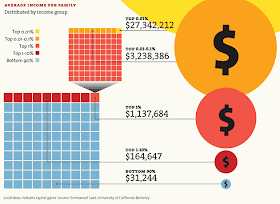 |
| Source: IBM, ASIDE |
Leading
educational thinkers have dubbed the current century the "Imagination Age," in which schools need practical approaches for teaching conceptual thinking. A
project out of the University of Louisiana at Lafayette, led by Rita J. King and Joshua Fouts, has assembled a
laboratory of resources and ideas to aid educators in teaching imagination.
GOOD magazine notes the directors' emphasis on "a time during which humanity must imagine and then create, together, the systems of the new global economy and culture." These rich
lessons and tools aim to "create the future of education and work."
 |
| Source: IBM, ASIDE |
In a similar vein, the
IBM THINK exhibit, celebrating creativity and innovation, ended its month-long staging at Lincoln Center in New York City on Sunday, October 23. The modestly promoted presentation honored the company's
100th anniversary by attracting curious crowds to its free, multi-sensory experience. Euro-techies and whiz kids mingled with century-savvy seniors in equal appreciation of the on-going pioneering work done with data. IBM's mesmerizing three-part showcase made for a rapt hour of education and enjoyment. It reminded us of
MOMA's riveting "
Talk To Me" display in its stunning visuals and enlightening facts. If you missed IBM's show, here are the take-aways:
The
exhibit unfolded in three successive parts: the data wall, the immersive film, and the interactive experience.
The data wall spanned the length of Jaffe Drive beside Avery Fisher Hall. In a benched alley, visitors could absorb streaming figures and extended visuals about air pollutants, boulevard flows, world nutritions, and other animated illustrations. Live sensors around the city – and around the world – collected statistics about exhaust and traffic to relay immediately to the enormous digital display. Much like starkness and immediacy make Washington, D.C.'s Vietnam Memorial an emotional experience, so, too, did the THINK wall ask humility in the face of everyday life.
 |
| Source: IBM, ASIDE |
After soaking in the graphic wall, ticket holders moved to the inside immersive film. A ten-minute broadcast flashed piecemeal on separate screens, inviting the viewer to submerge himself within distinct scenes played out on different displays. The video chronicled the impact of emerging technologies in improving life-expectancy and life-quality. Specifically, the THINK engineers emphasized five modes of thinking toward human progress:
- Seeing
- Mapping
- Understanding
- Believing
- Acting
 |
| Source: IBM, ASIDE |
Much like the
new vocabulary for educators, IBM's notions are the essence of creativity. At the end of the IBM film, each panel transformed into a dynamic touch-screen, on which visitors could explore the nuances of each mode of progress. With five different types of visual interactions, people roamed the room to prod the various forms of visual mapping. They explored means of predicting wealth, weather, and viruses. Each optical panel prompted a poll for viewers to become part of the accumulation of human data.
 |
| Source: IBM, ASIDE |
In all, the IBM THINK exhibit was noteworthy for its price (free), effort (considerable), and vision (progressive). The larger-than-life design of data made for captivating considerations of birth rates, agriculture, medicines, genomes, avenues, calendars, navigations, and energies. It was visual thinking in a democratic society. If every Fortune 500 company cheers its success with a similarly public commemoration, then we can applaud corporate karma.
 |
| Source: IBM, ASIDE |
 |
| Source: IBM, ASIDE |
For students, these lessons about the future of data usage offer thrilling conversations about energy, pollution, agriculture, and security. How to manipulate the world's mountains of information will define the nature of human progress. Teachers can nurture creativity and initiative within today's young people for them to emerge as generational leaders.
By the way, we have no affiliation with IBM. We just thought the exhibit was cool.






























